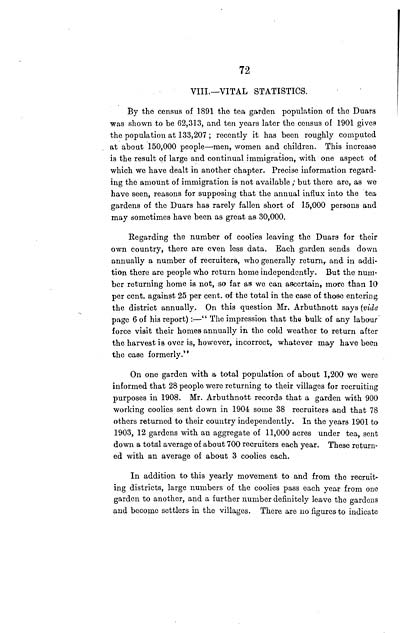Medicine - Disease > Malaria in the Duars
(84) Page 72
Download files
Individual page:
Thumbnail gallery: Grid view | List view

72
VIII.-VITAL STATISTICS.
By the census of 1891 the tea garden population of the Duars
was shown to be 62,313, and ten years later the census of 1901 gives
the population at 133,207; recently it has been roughly computed
at about 150,000 people-men, women and children. This increase
is the result of large and continual immigration, with one aspect of
which we have dealt in another chapter. Precise information regard-
ing the amount of immigration is not available; but there are, as we
have seen, reasons for supposing that the annual influx into the tea
gardens of the Duars has rarely fallen short of 15,000 persons and
may sometimes have been as great as 30,000.
Regarding the number of coolies leaving the Duars for their
own country, there are even less data. Each garden sends down
annually a number of recruiters, who generally return, and in addi-
tion there are people who return home independently. But the num-
ber returning home is not, so far as we can ascertain, more than 10
per cent. against 25 per cent. of the total in the case of those entering
the district annually. On this question Mr. Arbuthnott says (vide
page 6 of his report):-" The impression that the bulk of any labour
force visit their homes annually in the cold weather to return after
the harvest is over is, however, incorrect, whatever may have been
the case formerly."
On one garden with a total population of about 1,200 we were
informed that 28 people were returning to their villages for recruiting
purposes in 1908. Mr. Arbuthnott records that a garden with 900
working coolies sent down in 1904 some 38 recruiters and that 78
others returned to their country independently. In the years 1901 to
1903, 12 gardens with an aggregate of 11,000 acres under tea, sent
down a total average of about 700 recruiters each year. These return-
ed with an average of about 3 coolies each.
In addition to this yearly movement to and from the recruit-
ing districts, large numbers of the coolies pass each year from one
garden to another, and a further number definitely leave the gardens
and become settlers in the villages. There are no figures to indicate
VIII.-VITAL STATISTICS.
By the census of 1891 the tea garden population of the Duars
was shown to be 62,313, and ten years later the census of 1901 gives
the population at 133,207; recently it has been roughly computed
at about 150,000 people-men, women and children. This increase
is the result of large and continual immigration, with one aspect of
which we have dealt in another chapter. Precise information regard-
ing the amount of immigration is not available; but there are, as we
have seen, reasons for supposing that the annual influx into the tea
gardens of the Duars has rarely fallen short of 15,000 persons and
may sometimes have been as great as 30,000.
Regarding the number of coolies leaving the Duars for their
own country, there are even less data. Each garden sends down
annually a number of recruiters, who generally return, and in addi-
tion there are people who return home independently. But the num-
ber returning home is not, so far as we can ascertain, more than 10
per cent. against 25 per cent. of the total in the case of those entering
the district annually. On this question Mr. Arbuthnott says (vide
page 6 of his report):-" The impression that the bulk of any labour
force visit their homes annually in the cold weather to return after
the harvest is over is, however, incorrect, whatever may have been
the case formerly."
On one garden with a total population of about 1,200 we were
informed that 28 people were returning to their villages for recruiting
purposes in 1908. Mr. Arbuthnott records that a garden with 900
working coolies sent down in 1904 some 38 recruiters and that 78
others returned to their country independently. In the years 1901 to
1903, 12 gardens with an aggregate of 11,000 acres under tea, sent
down a total average of about 700 recruiters each year. These return-
ed with an average of about 3 coolies each.
In addition to this yearly movement to and from the recruit-
ing districts, large numbers of the coolies pass each year from one
garden to another, and a further number definitely leave the gardens
and become settlers in the villages. There are no figures to indicate
Set display mode to: Large image | Zoom image | Transcription
Images and transcriptions on this page, including medium image downloads, may be used under the Creative Commons Attribution 4.0 International Licence unless otherwise stated. ![]()
| India Papers > Medicine - Disease > Malaria in the Duars > (84) Page 72 |
|---|
| Permanent URL | https://digital.nls.uk/74558778 |
|---|---|
| Description | Chapter VIII.: Vital statistics |




